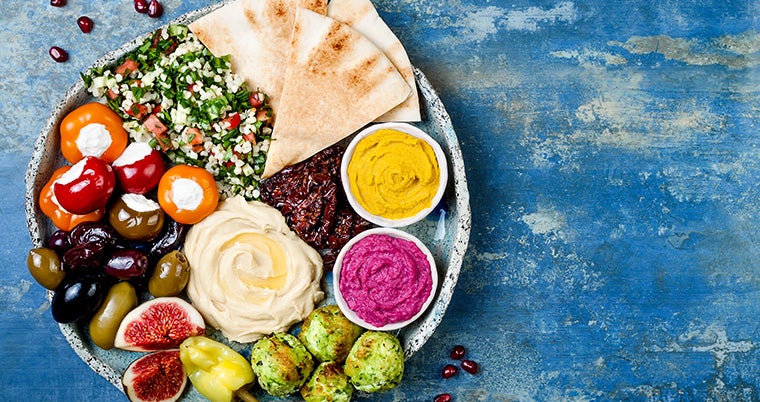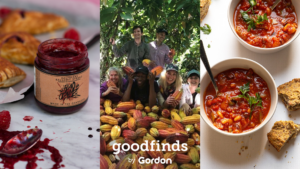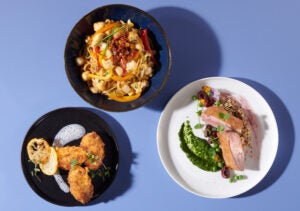Use this glossary to tell your food’s story on the menu.
Thousands of years in the making, Mediterranean foods are rich in history and flavour. Use this glossary as a guide to flavours and terms you can use to increase sales by telling the story of this exciting cuisine.
Aleppo Pepper: Named for the city in Syria, Aleppo red chile flakes are traditionally used to flavour kebabs and other grilled meats. They can be used to flavour beans, salads, muhammara, vegetables, pasta sauces, pizza and even chocolate-based sweets.
Baharat: Arabic for “spice,” baharat is an all-purpose blend (typically black pepper, cardamom, cloves, cumin, nutmeg, coriander and paprika) used in sauces, soups, grains, vegetables and meats.
Boquerones: These white anchovies are lightly pickled and finished with olive oil. Boquerones are refrigerated, not salted and packed in tins, and often used as an ingredient in Spanish tapas dishes.
Boureka: These baked, puff pastry turnovers are native to Turkey, but have been adopted elsewhere in the Mediterranean region. They are filled with ingredients such as potatoes, bacon, eggs and cheese.
Chermoula: This marinade, paste or relish is native to Morocco and commonly includes garlic, cumin, coriander, oil, lemon juice and salt. It is traditionally used to flavour fish or seafood, but can be used on meats or vegetables.
Couscous: This North African version of rice is made with small steamed granules of rolled durum wheat semolina. It provides more protein, vitamins and minerals than a comparable portion of rice.
Dukkah: Common in Egypt and the Middle East, this blend combines ground nuts, herbs and spices, such as coriander, cumin and sesame seeds. With an “everything” bagel consistency, it adds a crispy coating for fish, but also can be sprinkled on vegetables, eggs or hummus.
Freekeh: Popular in northern Africa, this cereal is made from green durum wheat that is roasted and rubbed, giving it a nut-like flavour and chewy texture similar to bulgur. Freekeh has more fiber and protein than quinoa.
Harissa: This hot chile pepper paste is native to northwestern Africa, with the name coming from the Arabic verb meaning “to pound.” Spice stall vendors in the region pound red peppers, garlic cloves, caraway and coriander seeds to create this zesty condiment.
Mezze: Another name for “appetizer,” mezze is an assortment of small dishes. Its contents vary by region—Greece, Lebanon, Turkey and the Balkans. Fruits, vegetables, dips and spreads (think hummus, yogurt and baba ganoush) are common.
Muhammara: A Turkish or Syrian spicy dip made using walnuts, red bell peppers, pomegranate colossus and breadcrumbs.
Olive Oil: Used in cooking, frying and dressings, this oil is the liquid fat produced by pressing whole olives. Like wine, its flavour can vary from harvest to harvest. It has antioxidants, antimicrobials and anti-inflammatory properties that offer health benefits.
Piri Piri: These spicy red peppers originated in the Americas, but have been part of Portuguese and African cuisine for centuries. The peppers are used to create a complex sauce that combines heat, sweetness and saltiness that makes a great rub for poultry.
Pita: These round, yeast-leavened flatbreads trace back thousands of years in the Middle East. Some versions are suited to be used as wraps, while other versions can be sliced and opened into fillable pockets.
Pomegranates: The fruit of a shrub native to the Middle East and southern Europe. Rich in antioxidants, its red-purple seeds (known as arils) have a sweet-tart flavour and are used in baking, garnishes and beverages, including juice blends, smoothies, cocktails and wine.
Pomegranate Molasses: A Persian seasoning made from concentrated pomegranate juice and used often in fish and meat dishes.
Preserved Lemons: Common in the Maghreb region in northern Africa, these pickled lemons add saltiness and depth to tagines, stews, dressings, sauces and more.
Sabich: An Israeli pita or laffa sandwich, often stuffed with fried eggplant, hard-boiled eggs, chopped salad, parsley, creamy hummus and pickles.
Shawarma: This word means “turning” in Arabic, and typically is the cone-shaped lamb or mutton cooked on a slowly turning spit and shaved for gyros or pita sandwiches. Modern versions include chicken, turkey and beef.
Sumac: Grown and used around the world, this bold red spice adds fragrance, colour and a bit of acidity to Mediterranean vegetable, lamb, chicken or fish preparations. With a slight lemon flavour, it can be used as a marinade, rub or sprinkled as a finishing touch.
Tagine: A flat-bottomed clay dish with a conical top, this cookware captures steam rising from ingredients as they cook, allowing the moisture to drip down the sides and into the dish, keeping foods moist.
Toum: Made with garlic, salt, olive oil and lemon juice, this sauce has the consistency of mayonnaise, with the pungent flavour of garlic. The Lebanese favourite is served with grilled chicken dishes, but works as a dip or condiment.
Urfa Biber: Also known as the “Urfa pepper,” these Turkish dried chile flakes are dark burgundy coloured with a smoky, raisin-like sweetness. It elevates all kinds of foods. Sprinkle it on vegetables as they cook, use it in salad dressings or season braising liquids.
Za’atar: A spice mixture that combines a variety of herbs (typically dried oregano, thyme, marjoram, sumac) and toasted sesame seeds. Some versions add cumin, coriander or fennel seeds. It’s often used to season meats, vegetables or to sprinkle on hummus.
Zhoug: Made with jalapeños, garlic, coriander and olive oil, this bright green sauce resembles pesto, but with a kick. Serve as a sauce with meats and fish, apply it lightly to vegetables, or even add a dollop to soup or hummus.

























